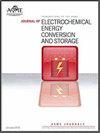Effect of Mn substitution on the structure and hydrogen storage properties of La0.75Ce0.25Ni5-xMnx alloy
IF 1.9
4区 工程技术
Q3 ELECTROCHEMISTRY
Journal of Electrochemical Energy Conversion and Storage
Pub Date : 2022-09-21
DOI:10.1115/1.4055694
引用次数: 0
Abstract
In this study, La0.75Ce0.25Ni5-xMnx (x = 0, 0.1, 0.2, 0.3) alloys were prepared by vacuum arc melting. The effect of the addition of Mn on the alloy microstructure and hydrogen absorption/desorption properties were explored by characterizing X-ray diffraction (XRD), scanning electron microscopy (SEM), laser particle size test, hydrogen absorption kinetic test, and P-C-T test. The XRD results show that the series of alloys are single-phase alloys composed of the LaNi5 phase, and the cell volume of the alloy gradually increases as the amount of Mn replacing Ni increases. The P-C-T curve of the alloy shows that the alloy has obvious hydrogen absorption/desorption plateau regions, which gradually decrease with increasing Mn content, while the hydrogen storage capacity remains unchanged. The hydrogen absorption kinetic curve of the alloy was tested, and it was found that the hydrogen absorption rate of the alloy increased with the increase of Mn content. These studies show that doping the Mn element in the La0.75Ce0.25Ni5-xMnx (x = 0, 0.1, 0.2, 0.3) alloys may regulate plateau pressure without affecting the hydrogen storage capacity or kinetics properties, providing a reference for the application of this type of alloy in hydrogen pressurization, purification, etc.Mn取代对La0.75Ce0.25Ni5-xMnx合金结构和储氢性能的影响
本研究采用真空电弧熔炼法制备La0.75Ce0.25Ni5-xMnx (x = 0,0.1, 0.2, 0.3)合金。通过x射线衍射(XRD)、扫描电镜(SEM)、激光粒度测试、吸氢动力学测试、P-C-T测试等手段,探讨Mn的加入对合金微观组织和吸氢/解吸性能的影响。XRD结果表明,该合金系由LaNi5相组成的单相合金,合金的胞体体积随着Mn取代Ni量的增加而逐渐增大。合金的P-C-T曲线表明,合金具有明显的吸氢/解吸平台区,随着Mn含量的增加,吸氢/解吸平台区逐渐减小,而储氢能力保持不变。对合金的吸氢动力学曲线进行了测试,发现合金的吸氢速率随着Mn含量的增加而增加。这些研究表明,在La0.75Ce0.25Ni5-xMnx (x = 0,0.1, 0.2, 0.3)合金中掺杂Mn元素可以在不影响储氢能力和动力学性能的情况下调节平台压力,为该类合金在氢气增压、净化等方面的应用提供参考。
本文章由计算机程序翻译,如有差异,请以英文原文为准。
求助全文
约1分钟内获得全文
求助全文
来源期刊

Journal of Electrochemical Energy Conversion and Storage
Engineering-Mechanics of Materials
CiteScore
4.90
自引率
4.00%
发文量
69
期刊介绍:
The Journal of Electrochemical Energy Conversion and Storage focuses on processes, components, devices and systems that store and convert electrical and chemical energy. This journal publishes peer-reviewed archival scholarly articles, research papers, technical briefs, review articles, perspective articles, and special volumes. Specific areas of interest include electrochemical engineering, electrocatalysis, novel materials, analysis and design of components, devices, and systems, balance of plant, novel numerical and analytical simulations, advanced materials characterization, innovative material synthesis and manufacturing methods, thermal management, reliability, durability, and damage tolerance.
 求助内容:
求助内容: 应助结果提醒方式:
应助结果提醒方式:


